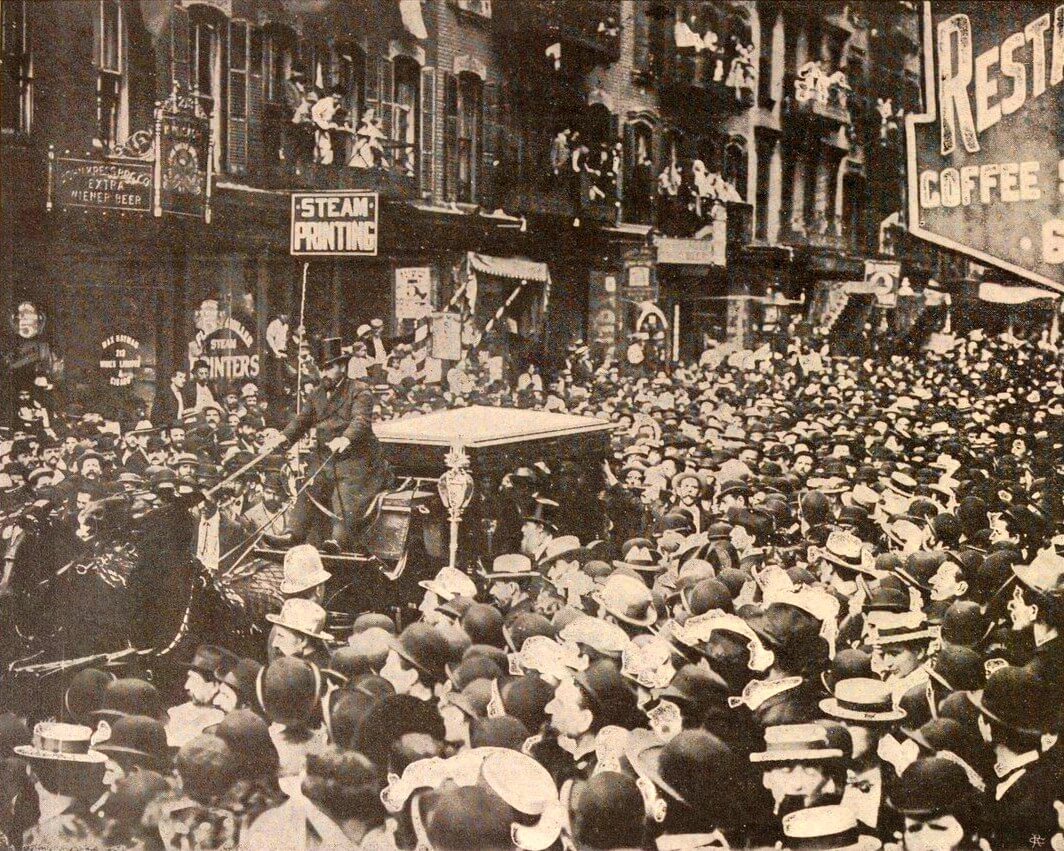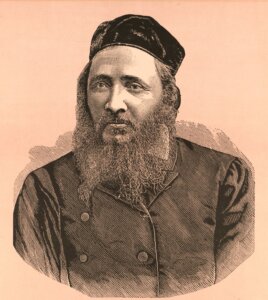How the biggest antisemitic riot in America transformed Jewish history
Scott Seligman’s new book looks back at the events surrounding the New York funeral of Rabbi Jacob Joseph

The 1902 funeral of Rabbi Jacob Joseph Courtesy of Wikimedia Commons
Does America’s worst antisemitic police riot have parallels with today’s world, or should Jews feel glad that the incident was a product of the era when it occurred?
In The Chief Rabbi’s Funeral: The Untold Story of America’s Largest Antisemitic Riot, which concerns the events surrounding the New York funeral of Rabbi Jacob Joseph in July 1902, author Scott Seligman examines the evidence for both sides of the question. Seligman patiently details the debris that was thrown onto the heads of participants in the Lower East Side funeral procession by local factory workers, including “dirty cotton waste, wet overalls, scraps of steel, oil-soaked waste, blocks of wood, buckets of grease, iron nuts and bolts, flat irons, screws, tools, bricks, bottles, utensils, stones, and even a dead cat.”
The hearse itself was bombarded with stale bread, pieces of iron and screws.
Some understandably outraged Jews reciprocated by directing bricks at the windows of the printing press factory from which these items emanated. When the police arrived, they used violence to clear the area, with the result that dozens of Jews, and a scant few factory workers, were injured.
The Yiddish Forverts led the way in denouncing the police brutality, in an editorial attributed to founder Abraham Cahan. Never shy about finding political lessons in American Jewish misfortunes, Cahan implied that the tragedy was at least partly the fault of Jewish voters who had failed to elect socialist officials who would care for them. Instead, the editor charged, the Jewish victims “put the clubs into the hands of those who are antisemitic and anti-worker.”
The Forverts diagnosed the episode as a “police pogrom” with the added irony that “even Russian peasants would have respected” a Jewish funeral, unlike the louts among US civilians and representatives of the forces of order. Of course, as the editorial board of the Forverts knew well, Russian pogroms usually included fatalities, which was fortunately not the case in 1902.
Perhaps for this reason, Meyer Schoenfeld, a labor leader, argued at a subsequent hearing that the attacks were not really antisemitic, on the grounds that they were done by “loafers and toughs, and are not the result of any sustained feeling.”

The Socialist Labor Party’s Arbeiter Zeitung echoed this opinion, disagreeing with the “hot Jewish ‘patriots’” who attempted to “construe from this tragic opera an antisemitic danger in this land.” Instead, the “stupid” factory workers probably would have perpetrated the same mayhem on “Chinese, Italians or other foreigners who, like the Jews, would have marched in large numbers without police protection.”
Undoubtedly there was continuous violent abuse of Lower East Side working class Jews by other ethnic groups, as noted in histories of the Jewish immigrant experience by Hadassa Kosak and Jenna Weissman Joselit.
The American Hebrew reported in August 1902 that impoverished Jews were seen as the “legitimate prey of the police.” Yet this oppression did not necessarily mean that Jews were singled out for torment, since the New York police force of the day repeatedly inflicted corporal punishment on crowds of every ethnic identity, including the Irish.
Yet for a century after the riot, Jewish authors readily assumed that the 1902 funeral riot made up part of a long history of anti-Jewish violence perpetrated in America by Irish immigrants. Stanley Feldstein’s 1978 The Land That I Show You: Three Centuries of Jewish Life in America charged that the Irish American police “vomited up their anti-Semitic feelings and attacked the Jews.” Howard Sachar’s 1992 History of the Jews in America concurred, deeming Irish New Yorkers a “traumatically impoverished, semi-literate” people with a “proclivity to violence” and “primal brutishness.”
Earlier, Irving Howe’s bestselling World of Our Fathers (1976) had asserted that the 1902 riot denoted a psychological “turning point” for Jews who hitherto had shown “resignation” when abused; in the wake of the funeral riot, they became convinced that “Jews had as much right as anyone else in America to claw and grab.”
This viewpoint has been disputed by later writers, who observe that in the 1870s and 1880s, from the Pale of Settlement to American electoral politics, Jewish activists were already at work and had no need to be galvanized by the events of Rabbi Joseph’s funeral.
Indeed, the facts surrounding the life and death of Rabbi Joseph help prevent over-idealization of that otherwise noteworthy figure in American Judaism. Born in Lithuania, he was bankrupted by bad investments, and became prone to melancholia, spending hours each day weeping in the Old Jewish cemetery in Sznipiszok, Vilnius.
Rabbi Joseph was rescued from these doldrums by an offer to relocate to New York to fill the newly invented role of chief rabbi by some congregations which hoped that a central authority might resolve ongoing disputes about kosher butchery and other issues. In the event, his arrival failed to resolve any of these problems, and Abraham Cahan was quick to explain why to his readers.
In a September 1902 article, Cahan granted that Rabbi Joseph was an accomplished Talmudist, but “remained the man of the third century he had been brought up to be.” For one thing, the rabbi never learned English, and some American Jews, accustomed to hearing Yiddish in humble domestic contexts, found it disconcerting when the rabbi used what some called the “jargon” to address theological and spiritual matters.
Cahan concluded that Rabbi Joseph soon became unpopular and died in America “like a flower transplanted to uncongenial soil.” Nevertheless, news of his death inspired tens of thousands of previously ambivalent mourners to feel genuine grief.
So trials and hearings were held after the riot, to little effect. A few policemen were transferred to different precincts or retired early. There were no sanctions against the factory or its employees. Yet Seligman, and others see the outspoken protests as an advance for American Jewry, if only because so far, no such large-scale anti-Jewish riot has recurred on US soil.
At one public gathering in 1902, Elias Rosenthal, a lawyer, expressed pride in his fellow Russian Jews, when he observed the factory windows which they had broken. Rosenthal added: “If I had my way, the whole establishment should have been razed and wrecked utterly with dynamite. I am no anarchist, at that.”
The sheer verve of the coverage may have made the most impressive imprint on the American Jewish psyche. The Arbeiter Zeitung scorned New York’s police commissioner for his inaction, calling him a “sleepy old bubbe who should be knitting socks, not be in charge of a police department.” This wisecrack, albeit unfair to grandmothers and needleworkers everywhere, underlined how the events clearly hit a nerve with the Jewish public.
The editor Abraham Hyman Fromenson, who introduced English language pages in the Yiddish press, took the occasion to publicly debate antisemitic press microagressions. In a September 1902 issue of The Fourth Estate, a journalism industry periodical, Fromenson asked why press headlines about crimes committed by Jews always mentioned the malefactor’s religion, whereas the faith of Christian criminals was never specified.
Even if such relative subtleties are the sole legacy of the grievous funeral riot of 1902, then it will have served a useful purpose for Jews today, despite the suffering it caused to those involved.
A message from our Publisher & CEO Rachel Fishman Feddersen

I hope you appreciated this article. Before you go, I’d like to ask you to please support the Forward’s award-winning, nonprofit journalism so that we can be prepared for whatever news 2025 brings.
At a time when other newsrooms are closing or cutting back, the Forward has removed its paywall and invested additional resources to report on the ground from Israel and around the U.S. on the impact of the war, rising antisemitism and polarized discourse.
Readers like you make it all possible. Support our work by becoming a Forward Member and connect with our journalism and your community.
— Rachel Fishman Feddersen, Publisher and CEO






























